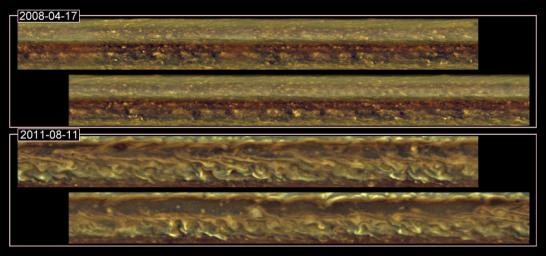This set of images from NASA's Cassini spacecraft shows cloud patterns in a band around Saturn before a monstrous thunder-and-lightning storm erupted and again after the head of the storm had disappeared. The images cover a band from 20 to 40 degrees north latitude. A comparison of the two images shows that the storm left the region in a highly disturbed, turbulent state. This kind of turbulence had never before been seen on Saturn and scientists are continuing to monitor the aftermath.
Cassini's imaging cameras obtained the data for the top mosaic on April 17, 2008, and the data for the bottom mosaic on Aug. 11, 2011. The great northern storm was first detected by Cassini on Dec. 5, 2010. It developed a bright head of clouds that moved swiftly westward and a clockwise-spinning vortex that drifted much more slowly. By early July 2011, the head of the storm had churned its way all around the planet, collided with the vortex and disappeared. The thunder and lightning declined around that time and stopped entirely by Aug. 28, 2011.
The red, green and blue channels of the image are assigned to their respective visible-light colors. However, the contrast of the image has been adjusted to bring out the turbulent cloud features, and the colors are not representative of the true colors of Saturn. The white spot in the center of the top panel of the Aug. 11, 2011, view is what remains of the large vortex that spun off from the storm.
The Cassini-Huygens mission is a cooperative project of NASA, the European Space Agency and the Italian Space Agency. NASA's Jet Propulsion Laboratory, a division of the California Institute of Technology in Pasadena, manages the mission for NASA's Science Mission Directorate, Washington. The Cassini orbiter and its two onboard cameras were designed, developed and assembled at JPL. The imaging operations center is based at the Space Science Institute in Boulder, Colo.
For more information about the Cassini-Huygens mission, visit http://www.nasa.gov/cassini and http://saturn.jpl.nasa.gov/.

 Planetary Data System
Planetary Data System












